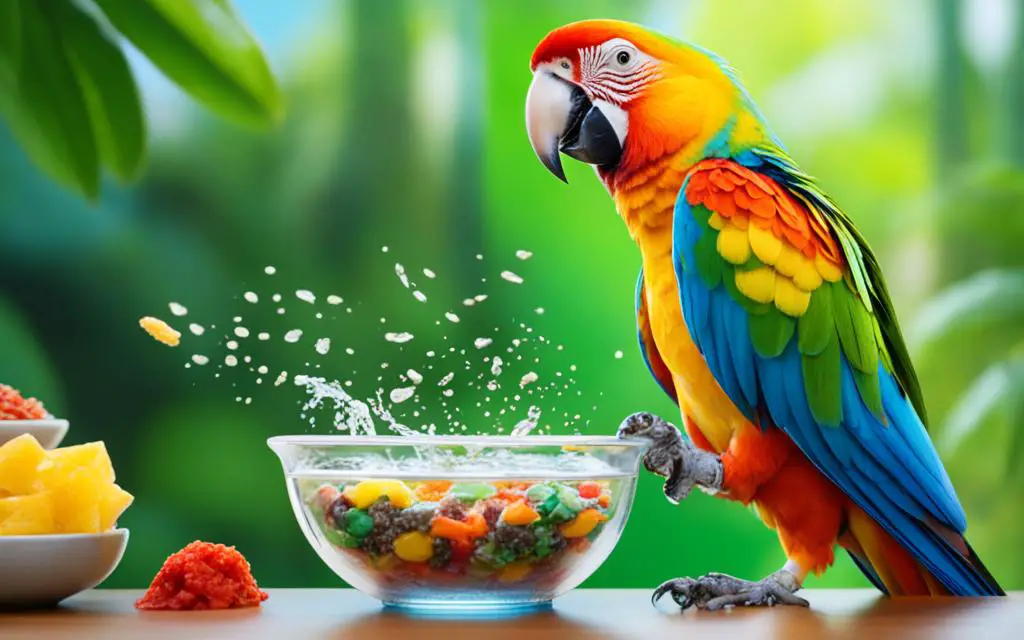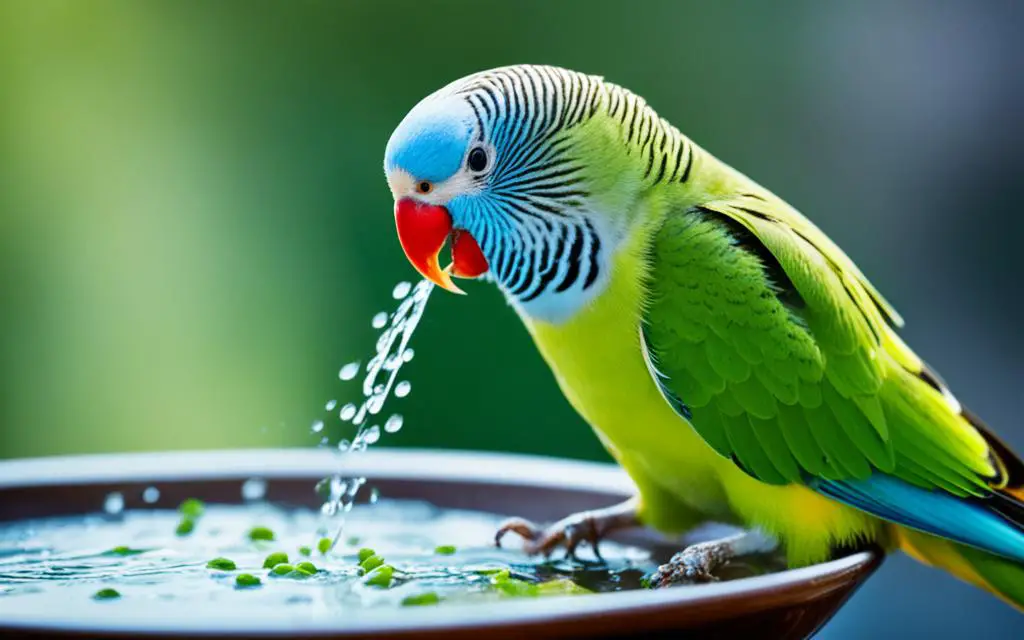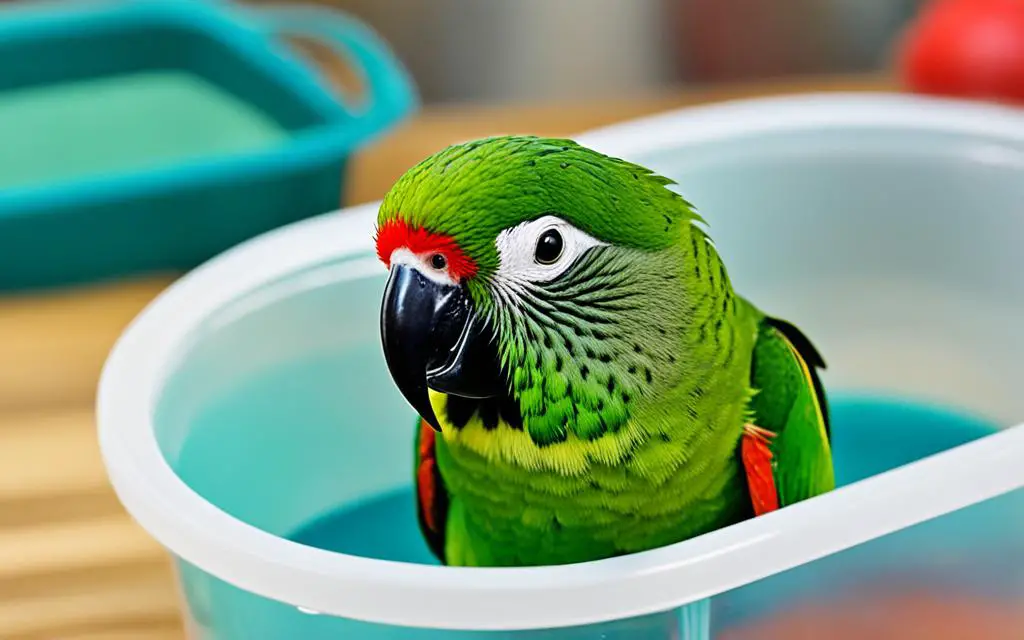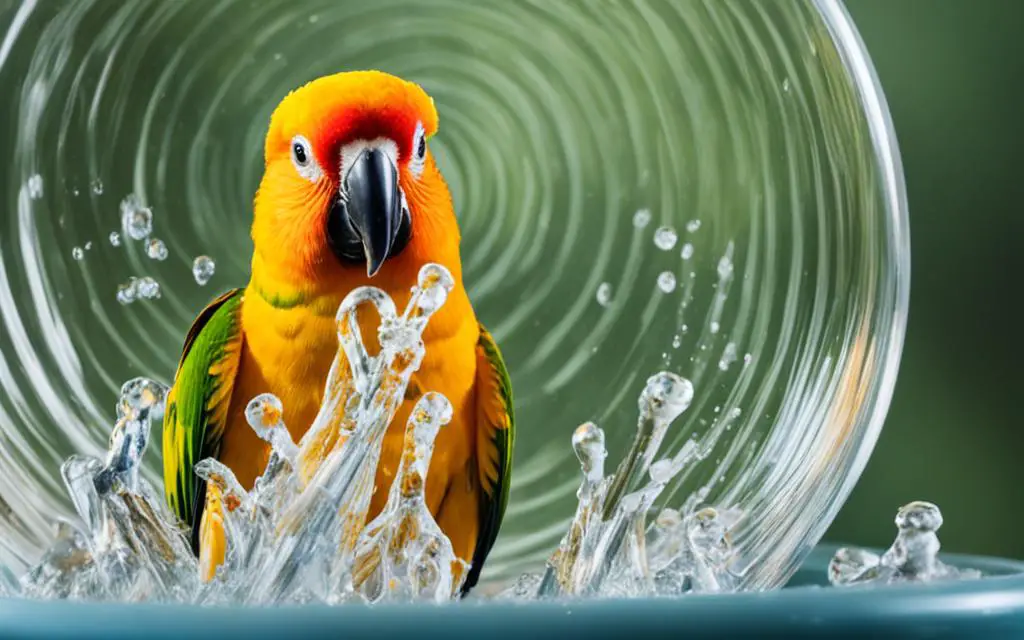Ever peered into your feathered friend’s water dish to find it transformed into a miniature stewpot? Welcome to the everyday reality of ‘Birdy Soup,’ the peculiar mix your avian companions concoct by dunking bits of their feast into their beverage of choice. This tapestry of bird behavior, where seeds flirt with water and pellets become soggy, is more than feathered whimsy—it’s rooted in avian feeding instincts tied to water. You’d be right to think it’s one of those strange bird habits that straddle the line between “cute” and “uh-oh.” Yet, the seemingly nonsensical act of a bird dipping food in water is a slice of everyday bird life, offering insights into the intricate world of avian behavior.
Your clever feathered friend isn’t just making a mess; they’re engaging in a bird behavior known as “birdy soup.” This instinctual habit can be due to a few reasons, like softening the food to make it easier to swallow, altering the food’s taste and texture, or possibly even a cleaning ritual. So while it might seem like your bird is being mischievous, they’re likely just following their instincts.
Perhaps you’ve laughed as your charming conure treated its water dish as a personal kitchen, or watched, fascinated yet flummoxed, as your caique turned hydration into a culinary experiment. This universal experience among bird-owners sheds light on an instinctual practice observed across various feathered species, compelling us to ask: why do our winged companions appear so intent on soaking their snacks?
Key Takeaways
- The creation of “Birdy Soup” is a prevalent behavior among pet birds, particularly noted in species like conures and caiques.
- Adding food to water may help soften it, catering to birds’ feeding instincts without the aid of saliva.
- Cleanliness is key—this habit can turn water cloudy, necessitating diligent water changes to stave off bacterial growth.
- Our avian friends’ penchant for dabbling food in water may extend beyond mere preparatory antics—it could be a multi-faceted behavior, including taste enhancement and cleaning.
- Understanding why birds engage in this behavior can help pet owners adapt and maintain a healthy environment for their companions.
Understanding Bird Behavior: The Quirks of Avian Mealtime
So you’ve found your bird’s penchant for turning its drinking water into a makeshift casserole mystifying? Take solace in the fact that such behavior is a common thread woven into the tapestry of avian habits. To unravel the mystery behind what prompts these winged companions to engage in such culinary gymnastics, a dive into bird eating habits around water and the implications of these behaviors is apt. Why do birds mix food and water? Is it a quirky flight of fancy or an instinctual ritual engraved deep in their DNA?

Distinguishing Between Species-Specific Habits and General Bird Behavior
The truth is that birds come as varied as a box of chocolates when it comes to their water-dining etiquette. Some species may exhibit unique behaviors; for instance, you might witness a cockatoo acting the role of a meticulous chef softening hard biscuits in water, a sight as surprising as it is indicative of their sophisticated palate. Other birds, such as caiques and conures, may seem like food-savvy mixologists, blending food and water to concoct the perfect meal.
Examining the Role of Texture & Taste Preferences in Birds
What might confound is the spectrum of avian behavior dealing with bird eating habits water. For these creatures of the sky, it’s not just about survival—it’s about enjoying the meal. By modifying their food’s texture and, possibly, its taste, birds seem to become gourmands of the air, savoring a texture that is just right under the beak or seeking a taste that dances delightfully on their taste buds.
The “Birdy Soup” Phenomenon Among Pet Birds
How about the avian all-you-can-eat buffet, aka the “Birdy Soup”? It’s an avian behavior that extends beyond mere nourishment—this soup-making may be an intuitive process similar to why do birds mix food and water? It potentially stems from a natural inclination to ensure their diet is not just digestible but downright delectable. Remember, this flavor-rich ritual will require your frequent intervention—cloudy water is an open invitation for bacteria to throw their own unsavory party.
So it comes down to this: your bird may be a connoisseur of fine dining, an innovator of flavor, or simply indulging in the avian ritual of taste and texture optimization. Cheers to their eclectic mealtime quirks!
The Science Behind Why Birds Dunk Their Food
Ever caught your feathered buddy in the act of baptizing their biscuit in their birdbath? There’s a method to their madness—a splash of science, if you will, that explains their dunking deeds. But why do birds indulge in this moist morsel magic? Let’s dive into the deep end of their dining pool and discover the ripple effects of their peculiar practices.

Softening Food for Easier Digestion
You might think birds are merely playing with their food, but there’s a practical purpose to this culinary choreography. Softening food is more than just a mess—it’s a must for our little beaked buddies. Without the luxury of human saliva, our avian amigos soften their provisions to ensure a smooth passage down their throat. So, when they’re soaking seeds, they’re not just making waves—they’re making their mealtime munching a bit more manageable.
Exploring Wild Bird Instincts in Domesticated Species
While it’s true that domestic bliss has tamed many of our winged companions, some wild bird instincts are too ingrained to ignore. The act of plunging pellets into their water dish may echo ancestral eating antics where moisture mattered most. For some, it could be a splash from the past—an inherited instinct that keeps them connected to their lineage, like a feathered family tradition.
Improving Food’s Taste and Texture: Insights from Avian Research
Recent research has ruffled some feathers in the world of avian aficionados. As it turns out, birds may be after a better-tasting bite or a more palatable piece. Observations of Goffin’s cockatoos deliberately soaking crunchy rusk in their drinking water hint they might be after that soggy sweetness or tender texture. These feathered foodies are as patient as a connoisseur waiting on the perfect vintage—they know what they like and they’re willing to wait for it.
Whether it’s tapping into their inner wild or seeking the perfect squish in their dish, your bird’s bath-time biscuit routine is a fascinating glimpse into their world—a world where flavor, texture, and the instinctual call of the wild blend in every bite. So next time you spot your bird turning their water dish into a spa for snacks, just remember: they’re not just fluffing around—they’re finessing their food to feathery perfection.
Practical Tips for Keeping Your Bird’s Water Clean
Hey there, eagle-eyed bird guardians! If you’ve done the whole “why is my bird’s water bowl looking like a science experiment” routine, it’s high time we tackle the globe-trotting journey of cleaning water bowls. To maintain safe water containers for your chirpy roommate and prevent food waste, a little know-how and regular upkeep are your best allies. And, between us, we all know no Michelin-starred chef would ever serve a side of bacteria with their entrees—so let’s ensure we’re not doing that for our feathered companions, alright?
First off, say goodbye to passive bird-parenting and get proactive with some cleaning food from your bird’s agua. Inspecting those bowls should be part of your morning ritual, second only to coffee. Spot a slimy surface? That’s bacteria’s red carpet welcoming party, so grab a brush and give that cesspool-in-the-making a scrub worth an Olympic gold.
Dreaming of a world where food bowls and water bowls exist in blissful separation? Keep dreaming—or better yet, make that a reality. Placing these vital resources on different cage levels might just trick those clever birb brains long enough to keep their snacks dry.
But hey, if your feathered pal is the mountaineering type, scaling peaks to make soup, it’s time for Plan B: the water bottle feeder. Yes, these nifty inventions could be the answer to your prayers—or a straight-up snub from a picky cockatiel. And remember, these aren’t “set-it-and-forget-it” gadgets; they need your tender loving care with daily cleanings.
Now, you might be pondering, “What about just adding another water bowl?” To that I say, “A for effort, B for spatial awareness.” If your cage real estate allows, sure, slap in another bowl, but don’t go crowding your budgie’s studio apartment.
Because when the curtain closes on another bird-bathed day, it’s all about keeping that water crystal—anything less just won’t fly. Now, flutter off and keep those water bowls worthy of a toast!
Why Does My Bird Put His Food in His Water?
So there you are, watching your feathered companion transform its water dish into a miniaturized flavor jacuzzi. Why do they do that? Is this some sort of birdie brunch spot for them? Indeed, this tendency to plunge food into their personal ponds is as widespread amongst birds as the latest diet fad in Hollywood. But fret not, as this splish-splash supper has scientific explanations and not just exotic bird antics.

Sure, you might want to chalk it up to birds being birds, enigmatic creatures with mysterious habits. However, don’t let this culinary conundrum ruffle your feathers. The truth is, your bird creating: birdy soup in their water dish is something many avian aficionados have observed. Before you throw in the towel (or the sponge), let’s peck away at the reasons behind why the need to mingle meals with water is nearly as important as the water itself.
Firstly, the hard facts: birds aren’t equipped with saliva to help soften their food, so their dives into the water dish are a way of making the grub more gulpable. Yes, that pelleted diet they love so much? Taking a swim. Maybe it’s part of their grand plan for esophageal conservation or beak health, but who’s to argue with a conure’s culinary technique?
Curiously enough, even soft-food aficionados among birds have been caught in the act. Maybe they’re trying to clean their kiwi or rinse their raspberries? Or could it be about adding that extra zest or flavor to their feast? Regardless of their reasoning, a little water with their dietary choices seems to be part of an intricate foraging behavior that takes bird mealtime beyond just sustenance—it’s a deep dive into gourmet waters.
Now, let’s not ignore the elephant in the room. Yes, the water. Changing it out more often than you update your social media status might seem over-the-top, but it’s vital for their health. That mashup in the water bowl isn’t just a potential mess—it’s a ticking time bomb for bacteria if not addressed. Cleanliness is next to bird-godliness, after all.
For your convenience and your bird’s health, here’s a comprehensive table on how often to change your bird’s water to avoid that dreaded bacterial bloom—all part of ensuring aviary bird dietary happiness and avoiding an unwanted petri dish scenario in their water dish.
| Bird Species | Frequency of Water Change | Additional Recommendations |
|---|---|---|
| Conures | 2-3 times daily | Use shallow dishes to limit food dunking |
| Cockatoos | At least twice daily | Consider offering food with higher moisture content |
| Eclectus | 3 times daily | Clean the water dish with a brush regularly |
| Caiques | 2-4 times daily | Offer a separate bathing dish to discourage dipping |
To sum it up, your bird’s behavior isn’t just a quirky twist to beak boredom—it’s an intentional action for sure. So the next time you witness that talon-to-water dish tango, know that your bird’s serving itself a bespoke blend, pampering its palate while attending to its digestive duet. Just make sure you’re on point with the water changes, and you’ll both enjoy the splashy mealtime rituals without the worry.
Adapting Your Bird’s Environment to Discourage Food Dipping
Let’s face it, watching your parrot prepare a gourmet batch of “birdy soup” in their aviary bird diet water dish might be endearing at first blush. But if you’re weary of playing sous chef to your feathered friends’ foraging behavior day in and day out, it might just be time to roll up your sleeves and outsmart the splash. Reworking your bird’s living quarters could be the key to promoting beak health without the watery mess.
Strategic Placement of Water and Food Bowls
Who knew that interior decorating could extend to bird cages? To curb your bird’s natural inclination to enhance their munchies with a dip, it’s time to get tactical. Arranging the water and food bowls with some savvy spacing could address the splash. Placing the bird mealtime water bowl on a higher perch and the food bowl below, or vice versa, could discourage even the most determined food dunker. After all, who would want to go the extra mile for a swim with every seed?
Considering Alternative Watering Options: Bottle Feeders
Perhaps it’s time to switch up the avian enrichment game with something a tad more challenging—enter the bottle feeder. If your plucky companion is turning their water dish into a soup kitchen faster than you can say “avoirdupois,” a bottle feeder with a ball-point tube might be your best bet. But remember, these contraptions aren’t self-cleaning—so put on your scrubbing cap and get down to detaching every day to prevent any sludgy surprises. Trust me, it’s worth the elbow grease.
Multiple Water Bowls: A Possible Solution for “Food Dunkers”
Running tight on vertical space? How about going wide? Introducing multiple water bowls within your bird’s abode might just be the distraction that turns the tide on their soaking spree. But before you whirl into a decorating frenzy, measure up—you don’t want to cramp your bird’s style or their flapping space. More bowls could mean more confusion for your culinary artist in feathers, potentially keeping your bird’s beak out of the water…quite literally.
Ultimately, keeping that drink clean and food-free is like pulling off the perfect pirouette—elegant, essential, and needing a touch of skill. So go forth, implement these strategies, and keep that water dish less soup kitchen and more sparkling sanctuary.
Conclusion
As the intricate ballet of bird behavior unfolds in your very own abode, it becomes vividly clear that keeping birds healthy and happy is an artful blend of vigilance and tenderness. While witnessing your avian acrobat wittily dunk its grub into its personal pool may invite amused chuckles, it simultaneously beckons a careful eye for the unexpected pirouettes of problematic behavior. With nutrition, cleanliness, and your bird’s idiosyncrasies skating in tandem, your flourishing feathered friend can enjoy both the symphony of their quirks and the harmony of good health.
When to Consult a Veterinarian: Signs of Problematic Behavior
So, you notice something’s aflutter beyond the norm? A seasoned bird guardian like yourself knows that the line between quirky and concerning can be as thin as a finch’s feather. Should dubious dining deeds transpire—perhaps a dramatic change in the food-in-water production or a water dish now resembling a murky lagoon—it’s time to chirp up. Seeking a veterinarian consultation ensures that behaviors throwing ripples in your bird’s health are skilfully scooped up and scrutinized. Bacterial growth in water bowls isn’t just unsightly—it’s potentially villainous to your birdie’s well-being.
Ensuring the Overall Well-Being of Your Feathered Companion
Here’s food for thought: your birdie’s sustenance stretches beyond the physical fancies of seeds and morsels. The nutritional needs of birds pivot on a fine axis where dietary variety, mental enrichment, and sparkling sanitation all have a perch. By mastering this triad, you’re not just a keeper of birds but a maestro of avian contentment. It’s your loving hand that crafts the nest of their overall well-being, where each tweet and trill is a testament to your care.
Embracing Your Bird’s Unique Habits While Promoting Good Health
Your feathered sidekick’s indulgence in transforming pellets into porridge or seeds into stew is part of their charm, isn’t it? Yet, through understanding and subtly steering these individualistic rituals, you promote a safe, robust, and happy life for them. Whether it’s rearranging the furniture in their cage or introducing a new watering method, you’re fluttering at the cusp of ingenious solutions to embrace and enhance their life. With a tweet of wisdom and a splash of resourcefulness, you ensure their whistles are whimsical, their coos are content, and their health—impeccable.
FAQ
Is it normal for birds to dunk their food in water?
What can I do to keep my bird’s water clean?
How can I stop my bird from putting food in his water bowl?
Should I be worried if my bird dunks his food in water?
Can changing my bird’s diet reduce dunking behavior?
How often should I clean my bird’s water bowl to prevent bacterial growth?
Are some bird breeds more prone to dunking their food than others?
Can using a water bottle feeder help prevent food from being dunked in the water?
What should I do if I notice my bird’s water is frequently dirty?
Why do birds sometimes leave their food soaking in their water?
Source Links
- https://www.ourfeatheredfriends.com/why-birds-make-soup/
- https://careforbirds.com/2019/09/22/why-do-birds-put-their-food-into-water-bowl/
- https://www.smithsonianmag.com/smart-news/watch-cockatoos-dip-their-food-in-water-to-make-it-soggy-180983432/

My name is Shane Warren, the author behind Your Bird Buddy – your ultimate guide to the wonderful world of birds! Unleash your inner avian explorer as we delve into a vibrant library of knowledge dedicated to all things feathered. From learning about diverse bird species from across the globe to understanding their captivating habitats and behaviors, I’m here to fuel your passion for these magnificent creatures. Not only that, but I also provide valuable insights on being a responsible and informed pet bird owner. Join our vibrant community and let’s celebrate the feathered wonders of the world together – one chirp at a time. And be sure to join our Your Bird Buddy Community over on Facebook!


Comments are closed